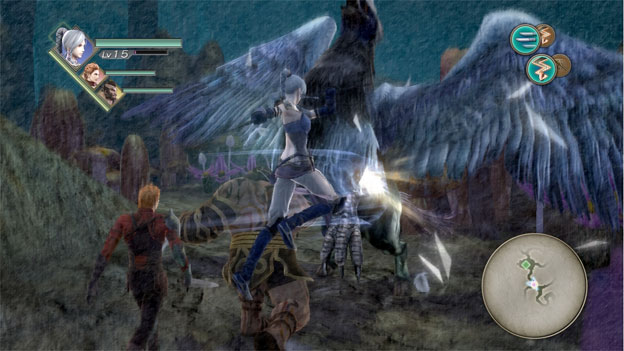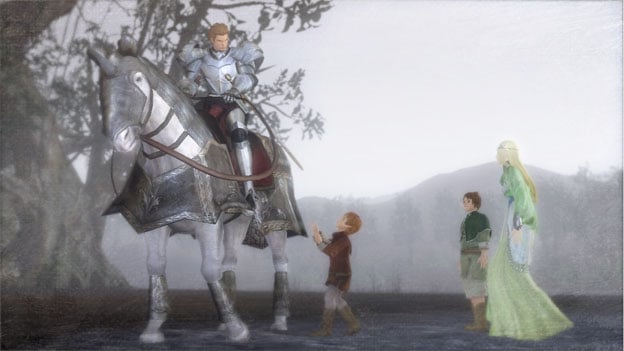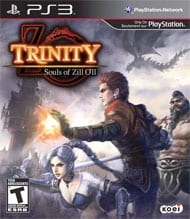The Tenacious Trinity
Trinity: Souls of Zill O’ll is the type of game that you could review in seven completely different ways depending solely on what mood you’re in at the time. It’s possible to play devil’s advocate and come up with all-new conflicting reasons why this game is great or why it’s terrible. Ultimately, I enjoyed myself with this game. It is incredibly far from perfect in so many ways, but it is a skillfully crafted game if ever there was one.
In most games, critics praise the art designers or the bug-free coding or the genius game design. In Trinity, the producers should be getting the real credit. It’s obvious from the outset that this game was made on a shoe-string budget. The cutscenes are simple pictures of the characters talking back and forth. There are also no actual cities in the game; it’s all just a menu screen with a picture of a city in the background. This is not an RPG operating with Bioware-sized budgets. And yet they managed to create a solid fifty-hour RPG, and that deserves commendation. The developers of this game clearly knew what the task was, they knew exactly how long everything would take to implement, and they made a better game because they didn’t shoot for the stars.

The focus seems to have been almost entirely on the boss battles and the combat system, which are the two main highlights of the game. The reason the game has so much potential to be divisive is that nearly every single other imaginable aspect of the game suffers in order to bring those two to the forefront.
The biggest issue is the lack of interesting questing content. There are occasional important story-based quests, but for vast hours in between there is a ton of busy work. When the game opens, you’re dropped into the world with nothing more for an impetus than “you want to get revenge on this guy, but you’re not strong enough yet. Go get stronger.” So you do quests and busywork until the story reaches its next major point. At which point you’re very likely to continue doing busy work for another large swath of time. The only thing that makes these MMO-style quests interesting is that you’ll occasionally meet other AI adventurers working on the same quests as you. You can then team up to take the quest down. This can happen multiple times in one dungeon. In one particular case, I had four random AI teammates help out my normal squad of three. Our seven person mega-squad made quick work of the end boss. It’s not game-changing, but it can give certain quests a more dynamic feeling.

A lot of people will have a big problem with that. Trinity isn’t for faint-hearted RPG fans. People who come to Trinity looking for an action-RPG in the same vein as Dragon Age will be disappointed. Although a comparison between the two is fairly apt, Trinity plays like a C-list Dragon Age. Considering how few games like this are in existence, that’s not necessarily a bad thing.
The similarity comes not just from the fantasy setting, but from the combat system. In at least this one case, Trinity beats out Dragon Age. Surprisingly, the combat system is a lot of fun. I wasn’t expecting to enjoy the combat of such a low-budget action game so much. After just the first couple hours you’ll have access to the three major characters (hence the title, Trinity) all of which fight very differently. As mentioned, the combat is similar to Dragon Age, with a more dynamic feeling. All characters have access to six abilities that you can program to the face buttons (three are available at a time, you can swap between sets with the trigger).

What’s neat about the combat system is that these abilities can affect the world around you sometimes. For instance, the main character’s ice attack has a chance to freeze enemies. But when that attack is done in water, it is not only guaranteed to freeze enemies, but it freezes a huge chunk of the pond with it. The same character’s fire attack can also light up nearby tumbleweeds that can roll into enemies for extra damage. In fact, numerous times that effect actually played into my strategy.
The graphics in Trinity aren’t up to the same mark though. They’re underproduced when compared to other games in the genre that are selling for a full $60. Trinity has a neat filter effect that drapes itself over the entire game that helps alleviate this problem somewhat. The overall effect is that the game looks like a storybook. It’s somewhat reminiscent of Valkyria Chronicles. Generally, though, it looks like this game could have been done on the PS2, and that’s a pretty damning statement to make about a full-priced game coming out over four years into the PS3’s lifespan.

The soundtrack, however, picks up some of the slack. The score is sweeping and dramatic. It’s certainly nothing new or surprising, but it’s everything you could want in a fantasy game of this type. The voice acting, on the other hand, is far more sporadic. The acting ranges from passable to painful as characters come and go in the plot.
The reason that Trinity: Souls of Zill O’ll is a hard game to judge is because it’s difficult to say that it could have been a better game. Given the resources they had to work with, I think the developer did an outstanding job of maximizing the output. It would have been much better, however, if they had realized the game was running long and trimmed it down. The final running time can be over forty hours, while the actual storyline probably only takes seven to twelve hours at most. A little side-questing and busy work is fine, but in this case, it is way over the top.
Omega Force made the best game they could with the resources they were given, but that doesn’t make it a better product for the gamers. At the end, what we have is a game that has highs that are canceled out by the lows. Had more money been invested in the product, we might have been talking about a new Demons’ Souls-esque surprise. Instead, we have a middling game that will be great for RPG fans, but too vacant for anybody else.
RATING OUT OF 5 RATING DESCRIPTION 3.0 Graphics
The graphics aren’t exactly bad, but aren’t exactly great either. A neat storybook filter saves it from looking horrible. 4.0 Control
The controls offer a good solution to the often convoluted Action RPG layout. 4.2 Music / Sound FX / Voice Acting
The soundtrack is sweeping and high quality. 3.3 Play Value
There’s a ton of content available, but far too much of it is repetitive. That said, if you enjoy leveling up and questing, then there’s 50+ hours of it here. 3.7 Overall Rating – Good
Not an average. See Rating legend below for a final score breakdown.
| Review Rating Legend | |||
|---|---|---|---|
| 0.1 – 1.9 = Avoid | 2.5 – 2.9 = Average | 3.5 – 3.9 = Good | 4.5 – 4.9 = Must Buy |
| 2.0 – 2.4 = Poor | 3.0 – 3.4 = Fair | 4.0 – 4.4 = Great | 5.0 = The Best |
Game Features:
